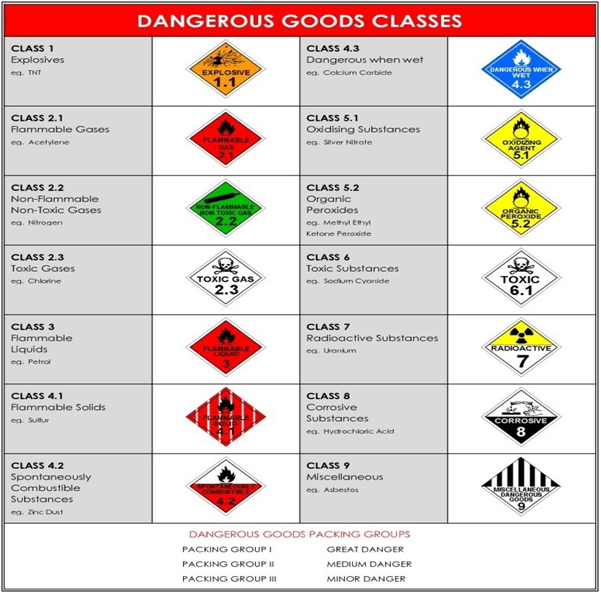Dangerous Goods (DG), as its names indicate, will result in severe consequences if handled incorrectly. Dangerous goods may pose a potential hazard to the safety and health to humans and the surrounding environment. It can also become a terrorist weapon that could cause potentially dangerous situations with disastrous outcomes. Transporting dangerous goods are often challenging, but with the proper infrastructure and technology, can eliminate risk and provides your business with a competitive edge.
Table of Contents
Compliance with Regulations
The United Nations (UN) modal cover principles of classification and definition of classes, packing requirements, marking, labelling or placarding, and transport documents.With this system in general use, all entities involved in the movement of dangerous goods would benefit from the time-consuming rules. Separate regulations exist for different modes of transportation.
The main regulatory boards are;
- International Air Transport Association (IATA), works closely with International Civil Aviation Organization (ICAO) in developing regulations to ensure safe and efficient transportation by air.
- International Maritime Hazardous Goods (IMDG), controls safe transport by sea.
- Accord Dangereux Routier (ADR), European regulations controls safe transport by road.
- Regulations concerning the International Carriage of Dangerous Goods by Rail (RID), control safe transport by rail.
- International Carriage of Dangerous Goods by Inland Waterways (ADN), control safe transport by inland waterways.
Identifying Dangerous Goods
Dangerous goods can be in solids, liquids or gases form. They may be in pure chemicals, mixtures of substances or manufactured products. There are nine classes of dangerous goods, each comprising of unique characteristics. They are assigned according to the most predominant of the hazard they present according to the nine classes of dangerous goods. Some items are broken down into sub-classes, so that they can be identified clearly with the associated risks. United Nation Numbering System (UN) is a four digits number assigned and used internationally for quick identification of dangerous goods. It will then be followed with a Proper Shipping Name (PSN) for the substance to describe it during transport. Example – Perfumes. It is categorized under class 3 (Flammable Liquids) with a proper shipping name of “Perfumery products with flammable solvents”.

Storing of Dangerous Goods
Dangerous goods are stored in warehouses for storage purpose or transit, and if they are not stored properly, they pose high risks of fires or explosions. This can be very risky, since it can lead to loss of life and property damage. Improper or rough handling can lead to serious injuries. To prevent such threats, complying to safety procedures need to be placed before and during operations. To operate a warehouse where hazardous substances are being stored, a strict guideline must be followed according to the Singapore Civil Defence Force (SCDF), National Environment Agency (NEA) and Workplace Safety and Health (WSH). Dangerous goods handling area must be segregated from normal warehouse activities area. Area must be properly secure from any unauthorized access. Safety and warning signs to be displayed to remind the potential risk when entering the area. The storage of hazardous goods must always be in limited amounts and must not exceed the limits set by the approval authorities. Material Safety Data Sheet (MSDS) or labels must be checked accordingly and must follow any storage recommendations since some dangerous goods require temperature control. A well-ventilated ambient or cooled temperature storage area with a racking system that complies with the height limit. Stored liquids on the lower shelves, with an accessible fire extinguisher or chemical spill kit in case of emergency.
Transporting Dangerous Goods
Transportation is a core aspect of logistics. It is important to be aware of the legislation on the transport of dangerous goods, since the transport of dangerous goods is riskier than the transport of regular goods. It must be carried out in full compliance with the laws of the country of origin, transit and destination. Dangerous products must be contained in special containers and permitted packaging in order to ensure the protection of the contents when on the move. Drivers transporting dangerous goods must be certified by the Singapore Civil Defense Force (SCDF) Hazmat Driver Course. Trucks transporting hazardous materials must be marked with the vehicle placard for easy identification during loading and unloading or emergency situations. Practice Last In and First Out (LIFO) for mixed cargoes and, if incompatible, for mixed cargoes, transport them in separate vehicles. Trucks fitted with a Global Positioning System (GPS) for maximum visibility in the transport of hazardous objects. Inter – modal transport is used regularly to transfer hazardous materials from origin to destination.
The full content is only visible to SIPMM members
Already a member? Please Login to continue reading.
References
Amran Hossain, DLSM. (2019). “Key Considerations for Warehouse Safety and Health”. Retrieved from SIPMM: https://publication.sipmm.edu.sg/key-considerations-warehouse-safety-health, accessed on 10/09/2020.
CAAS. (2020) “Carriage of Dangerous Goods”. Retrieved from https://www.caas.gov.sg/operations-safety/carriage-of-dangerous-goods, accessed on 12/08/2020.
Jean Beh Lee Chin, DLSM. (2020). “Key Transport Considerations for Integrated Logistics”. Retrieved from SIPMM: https://publication.sipmm.edu.sg/key-transport-considerations-integrated-logistics, accessed on 14/08/2020.
Mohammad Ihsan bin Othman, DLSM. (2020). “Critical Factors for Transporting and Storing Dangerous Goods”. Retrieved from SIPMM: https://publication.sipmm.edu.sg/critical-factors-transporting-storing-dangerous-goods, accessed on 12/08/2020.
Zhang Zhongwei, DLSM. (2020). “Major Considerations for Chemical Warehousing”. Retrieved from SIPMM: https://publication.sipmm.edu.sg/major-considerations-chemical-warehousing, accessed on 10/08/2020.






